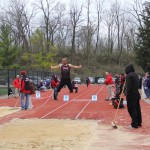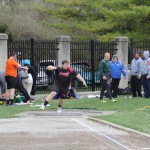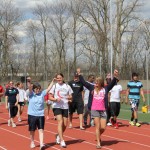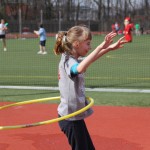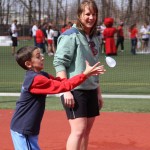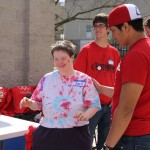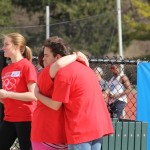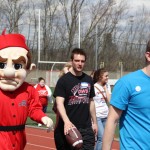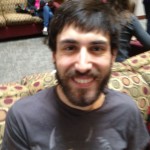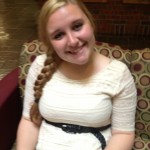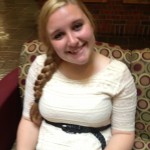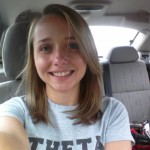Author: Phoebe Christine Bush
Lacrosse defeats DePauw despite inclement weather
By Jimmy Sanzone
Transcript Correspondent
Ohio Wesleyan’s men’s lacrosse team overpowered DePauw University this past Wednesday, blowing by the Tigers for a 24-2 victory at Selby Field. The Bishops’ record improved to 9-4, while the Tigers fell to 0-10.
OWU started the game well on offense, scoring six goals by the 9:45 mark in the first quarter.
After two DePauw turnovers in a span of 25 seconds, senior midfielder Pat Bassett assisted junior attacker Casey Helms to give OWU a 7-0 lead just seven minutes into the game. By the time lightning caused a delay with 3:59 left in the first quarter, OWU held an 11-1 lead.
“One of our juniors, Spencer Schnell, really brought a lot of energy and the entire team fed off him,” OWU freshman defenseman Mike Knapp said. “We got off to a good start but we thought we should have taken better shots.”
Less than seven minutes into the second quarter, the Bishops extended the lead to 18. Freshman attacker George Rice, who scored two goals to give OWU a 19-1 lead, led the charge.
A six-minute scoring drought from both teams, which included three OWU turnovers, came to an end with 2:39 left in the first half when OWU sophomore attacker Edwin Foster scored off sophomore Tommy Minkler’s assist.
The duo repeated the same actions just minutes later, again scoring giving OWU a 21-1 lead going into halftime.
The beginning of the third quarter showed more of the same from the Bishops, who quickly scored twice by the 14:04 mark to gain a comfortable 23-1 lead over the Tigers.
DePauw midfielder Michael Strader was the sole bright spot for the Tigers, scoring for the second time with 8:37 left to play in the third quarter. This was the final goal the Tigers scored.
After much stagnant play from both teams, play was stopped again for almost three hours due to more intense lightning. The players kept themselves entertained during the wait.
“We had some music playing and we were dancing around, just bonding as a team,” OWU sophomore midfielder Nico Pariambada said. “Some guys were out in the tunnel playing wall ball keeping their stick loose, as well.”
After almost three hours, play resumed with undesirable weather. Just three minutes into the fourth quarter, the game was called after another lightning sighting.
One of the keys to the game for the Bishops was time of possession. OWU dominated the ball for the entire game with a combination of smart passes on offense and good energy on defense.
“Our offense did a great job controlling and possessing the ball so when it came to our side of the field we had plenty of energy to play great fundamental defense,” Knapp said.
Senior Colin Short, Foster, Minkler and Schnell each tallied three goals by the time the game was called. Senior Jaime Vavrek collected four assists for the Bishops.
‘Young’ baseball team struggles to compete with conference rivals
By Hugh Kerins
Transcript Correspondent
Ohio Wesleyan’s Bishops baseball team started off slow in conference play against DePauw and gained momentum by beating Denison, but then showed lack of experience down the stretch.
On April 6 and 7 the Bishops traveled to Greencastle, Ind., to face conference opponent DePauw for a weekend series.
The Bishops started out strong, taking the first game 8-3.
During the game senior Ben Steele came up with three RBI’s and a home run. Other big contributors were junior Sean Vollenweider, freshmen Steven Moore and Taylor Hutchinson, who each had two hits and an RBI.
After the first game, the tide turned quickly—DePauw beat the Bishops in the next three games 3-9, 3-4 and 8-10, respectively.
In the last two games on April 7, the Bishops made late comebacks, but fell short at the end of both.
“Our team struggles to come out of the gates and jump on teams,” senior James Tolland said. “It is almost as if we need four innings to get warmed up or something, and by then it’s almost too late sometimes.”
Standouts in the two losses were Vollenweider, who collected a total of five hits along with three RBI’s; first baseman Toland collected five hits.
Steele said he thinks the team will improve despite its youth.
“… I believe we are really coming together as a team and fighting back in different games,” he said. “There has also been a great amount of hard work that helps us win games.”
The Bishops continued conference play the following weekend after having their game against Otterbein University canceled due to inclement weather.
With continuing conference play, the team came back from the tournament with a game against Denison at Littick Field. On April 13 the Bishops collected two big victories. The final scores were 11-0 and 5-2.
Vollenweider, Steele, Toland and sophomore J.J. Buckey drove in two runs apiece to power OWU over Denison in the opener of the double-header.
The Bishops broke the game open in the fourth inning, collecting seven hits and adding a pair of walks and a sacrifice fly along the way. Vollenweider’s two-run single capped the eight-run rally.
During the second game, Denison took an early lead, but that would be it for the Big Red—sophomore pitcher Charles Cooper blanked the visitors on one hit over the next six-plus innings of action. The final score of the game was 5-2.
On the following day, April 14, Denison got its revenge with two solid victories against the Bishops, and showed no mercy in either outing. The Big Red beat OWU with final scores of 1-6 and 3-17.
“This is where we show our youth,” said sophomore Paul Priddy. “We are young and we’re still trying to get our legs under us. As a young team we have a lot of potential, and I think are really going to do great things as the year progresses.”
The Bishops continue play on April 17 at Capital University.
Bishop Champion Games celebrate different abilities

Transcript Reporter
and Phillipe Chauveau
Transcript Correspondent
The weather was warm and so was the atmosphere at this year’s third annual Bishop Champion Games.
The Ohio Wesleyan Athletic Council sponsored the event; proceeds went to expenses for next year’s games. The games’ website said its events are geared to participants with special needs ages 8 and up.
Sophmore Kylea Davis was in charge of the Games this year. She said she was “honored” to put on the event.
“We can all learn a lot from each other, I feel it’s not the responsibility but we, as athletes, should be using our abilities to celebrate the abilities of other athletes,” she said.
Student-athlete volunteers staffed the event. Some helped set up and cheer on the athletes, while others were assigned to be buddies of athletes. Buddies helped athletes find their way around and perform better in each event. Freshman Sara Johnson, a member of the OWAC, was assigned as a buddy.
“He was a bit shy and wanted to sit with his parents first but after I showed him that we had balloon toss, he came out of his shell,” she said.
After 10 minutes for the athletes to get to know their buddies, they were directed to their respective competitions, starting with the Softball Toss and the Football Toss.
The athlete’s throws were measured and the top results were recorded, but the real point of the events was to have fun. After their turns, competitors would throw the balls around between themselves and with the volunteers, creating a friendly environment for everyone.
Next up, the athletes competed in 20- and 50-meter dashes. The races went by quickly, and they were very interested to see how fast they could run.
Senior Emily Johnson, an OWU athlete, has volunteered at all three Bishop Champion Games events. She said working with this year’s competitors “brought tears to (her) eyes.”
“I run cross country and track here at OWU, and often forget to be grateful for the fact that I am blessed with the ability to run, let alone walk,” she said. “Just seeing the participants in these events reminds me to be thankful for what I have. Instead of being upset that I didn’t run two seconds faster in my race, I should be thankful that I have to legs to run with at all.”
Junior Holly Fouch, another OWU student-athlete who helped with the games, said she learned a lot from the event that she plans to apply to her own athletic career.
“Winning is always fun, but it’s the relationships with others and the memories from them that will last throughout the years,” she said. “It just help(s) put everything in perspective that regardless of physical capabilities every athlete involved was giving their best and it was incredibly inspiring to watch.”
OWAC had a little more help with this year’s game from fellow NCAC school Hiram College.
Hiram recently started its own athletic council and was looking for way to expand their program and give back to their community.
“Going to other people’s events and seeing how they run them is definitely going to help us,” said Hiram freshmen Emily Mortimer.
Hiram brought about 10 student athletes two hours and 15 minutes by van to the games to help and learn from the experience. Hiram senior Katie Valaitis said the collaboration with OWU is an effort to “raise awareness and knowledge,” building on other service-oriented campaigns like Relay for Life to garner support for a similar event there.
I think it’s great and is something that more colleges should do,” she said.
Johnson recalls the games’ closing ceremonies as her favorite part, and one of the most emotional.
“(We all lined) up to create a tunnel for the athletes to run through during the awards ceremony,” she said.
“As they ran through, all of the OWU athletes held out or hands for high fives and cheered for them.”
The truth about voter turnout rates
News Editor
It has only been a few months since voters across the country went to booths and voted on candidates for all offices of government. However, it will not be long before the campaign signs and television advertisements start up again to mobilize voters for the midterm elections in 2014.
With every election comes the analysis of voter turnout data, a way to review how many voters actually show up to vote on Election Day. Analysis of this data can show trends, increases and decreases in voter turnout depending on the year and what offices are up for election.
Ashley Biser, an assistant professor of politics and government at Ohio Wesleyan specializing in contemporary political theory, identified four factors that can influence voter turnout in any election: institutional factors, election profile factors, luck and socioeconomic factors.
Institutional factors would include things such as if the state offers same day registration, if early voting is available, if there is automatic voter registration and even the factor that voting day is not on a weekend or a national holiday in America.
“We’re one of the few countries in the world that doesn’t have a national holiday for voting, or that doesn’t have it on weekends,” she said. “…and part of that has to do with the fact that voting in the United States is so much of a state issue and not a federal one. It’s a lot easier to put in place those kinds of rules when you’re dealing with a more unitary system or it can come straight down from the federal government and not be so much at the state level.”
For the election profile factors, Biser said those who study politics know general (presidential) elections tend to have higher turnout than midterm elections because of the attention they get and because there are sometimes big issues on the ballot to be voted on.
The greater attention would also lead to more get out the vote efforts by various campaigns to try to increase voter turnout. Luck factors, such as what the weather is in a given area, can also influence election turnout.
Socioeconomic factors include variables like whether or not the parents of the voter voted themselves and the income levels of the person can also influence if the person goes to vote.
The Data
The voter turnout data used in this story is from the United States Elections Project, which, according to its website, is an information source for the United States electoral system with the mission of providing timely and accurate election statistics, electoral laws and research reports to inform the people of the United States on how the electoral system works, how it may be improved and how they can participate in it.
This data comes from the research of Michael McDonald, an associate professor at George Mason University and a non-resident senior fellow of the Brookings Institution, a nonprofit think tank based in Washington, D.C. The United States Elections Project website can be found at http://elections.gmu.edu/.
McDonald cites different ways to calculate the voter turnout rate depending on what portion of the population is used on the United States Election Project website.
The voting-age population (VAP) is found in everyone residing the in the United States 18 years of age and older. The voting-eligible population (VEP), on the other hand, encompasses the population that is eligible to vote, which eliminates non-citizens, felons and mentally incapacitated citizens.
He indicates on the website that VEP statistics are a more valid calculation for use over time and across states. The VAP statistics can be problematic when applied to states because the number of ineligible voters (felons, for example) is not uniform across different states.
Additionally, the data was condensed further into VEP highest office turnout rate, which is how many people voted for the highest office on the ballot (the governor or senator for midterm elections, and the president for general elections).
These statistics are turned in by every state; therefore, the traditional numbers reported of people who voted in elections, according to McDonald’s website.
National Turnout Rates
The data from the graph on McDonald’s website shows a decrease in the national VEP turnout rates of about 12 percent from the 1960s to the 1970s. While specific percentages were unavailable for the years prior to 1980, this decrease is clear on the graph. Since 1980, the percentages have steadily increased to percentages close to what they were in the 1960s and 1970s.
Biser said some of the drop could be attributed to general dissatisfaction with the government.
“…I think in general we see a sort of frustration with government, and I think it’s a frustration that many people can understand, with the real question about, ‘What are these people doing that’s going to affect my life?’” she said.
“There’s an incentive to be a free rider and to let other people, the people who are really invested, to let them be the ones to do the work.”
Joan McLean, an OWU professor of politics and government and former political advisor for Democratic vice-presidential candidate Geraldine Ferraro, said this drop could be partly due to the differences in the electorate. As the country passed laws giving younger people and minorities the right to vote, this increased the size of the electorate. However, she said it generally takes a generation for new members of the electorate to develop the habit of voting.
“So, I would speculate that could account for some of the decline, and then the bounce back could be that the issues of importance to these two voting groups, minorities and young people, have gotten much more play in the last decade or so,” she said.
“Then, when you see with the Obama campaign appealing to both of those groups, it begins to set a pattern of interest because we know what people do early on in their voting life is what they do later on.”
For general election years, the national average stayed within the low to mid-50-percent range in the 1980s and the 1990s.
The only exception is a spike in the 1992 elections, where the national average jumps from 52.8 percent in 1988 to 58.1 percent in 1992 and back down to 51.7 percent in 1996.
The 1992 election was the year when Bill Clinton ran as the Democratic Party candidate, George H.W. Bush ran as the Republican Party candidate and Ross Perot ran as an independent. Biser said Perot running as a third candidate could have had an effect on turnout.
“I think that it was a heavily contested election,” she said.
“There were choices and there was a third candidate, and that makes things more interesting. Our system is not designed to have third candidates do well. It’s designed for a two-party system, and it’s going to encourage a two-party system. I think another institutional factor is…often times places that have more parties on the ballot have higher turnout because you feel like you have more choices.”
The next major jump in the national average comes in 2004, where the VEP goes up to 60.1 percent. The percentage stabilizes and the final data available from the 2012 elections is a VEP of 58.2 percent.
McLean said the spike could have been due to amendments for same-sex marriage bans on state ballots in 2004, causing many more social conservatives wanting to go out to vote to get the amendments passed.
The national rates for midterm election turnout, however, are much lower than the presidential election years. Biser cited reasons why this is so much lower as well as the impacts statewide elections can have.
“I think there’s a lack of understanding in terms of the impact that statewide elections can have,” she said. “If you look at the Tea Party, if you look at other sort of movements, they’ve actually been very effective in local elections.”
She said the Christian Right, a right-wing political group, has been extremely effective in local contests like school board elections. She said local elections are also important because they give candidates practice in running an election.
“I think that a lot of times we only focus on the bigger elections when, in fact, there is a lot of underground work going on at the local level that we should pay more attention to,” Biser said.
McLean agreed with Biser’s notion of a lack of understanding in the impact of local elections.
“…Midterm elections, you have to be more deliberate in one of two ways: you accept the civic responsibility that voting is important or you’re moved to vote because one of the issues or candidates is important to you,” McLean said. “…The government that has the most impact on day-to-day lives is the local and state. Yet, it is the least paid attention to when it comes to voting and voter turnout.”
There is also less of a difference between the high and low points in turnout from 1982 to 2010, the years the data was available. The national average was at its high point in 1982 at 42.1 percent and at its low point in 1986 and 1998 at 38.1 percent.
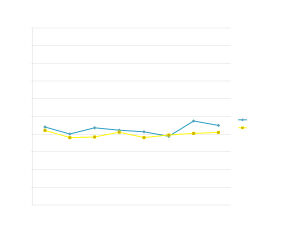
While Ohio VEP turnout rates for general elections had jumps in the same years as the national rates, the Ohio percentages are consistently higher.
National turnout rates hovered around the mid-50-percent range for most of the period between 1980 and 2000 with an increase to the low 60 percent range from 2000 to 2012. Ohio rates, however, started in the mid-50-percent range and increased to the mid-60-percent range in the years 2000 to 2012.
The closest the national turnout rates came to Ohio’s rates from 1980 to 2012 was in 1980 when the difference was 1.9 percent. From that point on, Ohio turnout rates were 2 percent or more above the national rates, even getting as much as 6.7 percent higher in 2008.
McLean described why Ohio being a swing state in elections can impact voter turnout percentages.
“Swing state means that it’s politically divided and open to voting, so you’re getting both party’s candidates,” she said. “People think their vote counts.
“We know people are more likely to vote when they think their vote counts or makes a difference.”
Biser agreed with McLean, going back to Ohio’s swing state status being a major institutional factor.
“What makes it (Ohio) a battleground state has to do with the electoral college, and so I think it makes sense that since your likelihood of having an impact on the election is much higher,” she said.
“We said in Bush versus Gore in 2000 that…all those questions about, ‘Will my vote count?’–that’s a really important question in swing states, and so I think that a swing state, one you know isn’t going to go one way or the other, makes a difference.”
This holds true for midterm election years, as Ohio’s VEP rates stay in the low-40-percent range from 1982 to 2002, only dipping below 40 percent in 2002 at 38.80 percent.
However, the major difference comes in the jump after 2002 with VEP rates going up to 47.5 percent in 2006 and dropping slightly to 45 percent in 2010. The national rates did not experience a jump nearly as large as this in midterm election years.
McLean said part of the reason for some of the different jumps for Ohio and the National VEP rates for midterm elections is Ohio featuring a gubernatorial election in midterm election years. Not all states elect a governor at these times, so highly contested races for governor could be a reason for Ohio’s higher VEP rates in midterm elections.
Moving Forward
While the data shows the voter turnout rates have been steadily increasing since the 1980s, there is still only roughly 60 percent of the population showing up to vote nationally in general elections.
McLean said there are a few factors that could influence whether there’s an increase in turnout.
“Clearly, people have to think that voting matters and that they have choices,” she said. “…It would be very hard to guess the impact that political partisan politics and the election nearing politics is going to have. When you have high voter turnout, you have people who believe in the system.”
From a campaign and voter mobilization perspective, both Biser and McLean commented on the impact of get-out-the-vote efforts and technology.
Biser commented specifically on how after Republicans lost in 2008, the party learned they could not just rely on their base and that the Obama campaign had done a great job in terms of the ground efforts to get people to go vote.
McLean said technology has allowed for more sophisticated voter targeting and tracking for campaigns.
She said the down side to the all of the technology and voter mobilization efforts is “voter contact fatigue,” which could ultimately hurt the campaigns if they bother voters too much.
More to the Story
While all of this data points to voter turnout percentages increasing, there are still many factors to consider. One such factor, Biser said, is the use of VEP rates as opposed to VAP rates.
“This is already a smaller subset of people and that doesn’t include the people who have been disenfranchised through felon disenfranchisement and all of those things,” she said.
“I think that’s actually a really huge problem. I understand the reasons for it, but I also think that if you look specifically at the racial dimensions of felon disenfranchisement, it is a huge problem for civil rights in this country.”
There are many more factors that can be explored through this topic, such as looking at specific socioeconomic factors, using a median of national voter turnout rather than an average and comparing each state.
There are many reasons people show up to the polls some elections and not others.
While this covers the broad idea of the changes and truths about voter turnout rates, there is much more to the story to cover why many of the changes in turnout occur and what it means for the future.
OWU’s four most popular majors reflect university’s diversity

By Elizabeth Childers
Managing Editor
While Ohio Wesleyan offers an array of majors in several departments – 93, according to OWU’s website – over the past five years, and according to the current declared majors, there are four who seem to draw in the most students: Zoology, Psychology, English, and Economics respectively.
These four departments being the most popular are significant in showing the diversity at OWU. Though the university is known for its science programs (OWU is one of the few in the country to offer zoology as a degree and as a separate department, which is a large draw to prospective students), the four departments with the highest number of students with declared majors are as diverse as what 93 majors would suggest. All four of these programs are also listed by the Princeton Review as some of the top ten majors in the country.
“Be warned, however, that these are not necessarily the degrees that garner the most demand in the job market,” the Princeton Review writes. “More importantly, they don’t lock you into a set career path. Each major offers unique intellectual challenges and develops skill sets that will be applicable to various careers.”
The four departments listed here – zoology, psychology, English and economics – are all very different routes of education, but all seem to do the same thing: preparing students for a wide array of different jobs focusing more on the skills and thinking styles taught by each discipline.
Zoology
Zoology currently has the most number of declared students, with 94 as of this month. The department is home to several pre-professional programs such as pre-vet and pre-med as well as home to a general Zoology degree.
The department’s chairperson, Dr. Ramon Carreno, said they have a prevalent number of prospective students come in to both sit in on classes and speak with members of the department. OWU is one of the few universities who has a department specifically labeled zoology, and Carreno said that’s definitely part of the lure for new students to come and take a look. Prospective students come from all over the country and from overseas.
Depending on what type of degree students pursue in the zoology department, students can have different expectations about their curriculum. Pre-professional programs in zoology tend to have a much stricter set of pre-required classes as opposed to a general zoology degree, Carreno said. Often times, if students change their directions in the zoology department, they either move from a pre-professional route into a general zoology degree, or leave zoology altogether to join a different department either in the social sciences or humanities.
“We don’t work as a training facility for future employees to have some sort of skill they can use working somewhere,” Carreno said. “Our biggest priority here is to train our students as thinking scientists. Our intro courses strongly emphasize the scientific method and the laws of science and thinking like a scientist.”
The introductory courses for zoology focus on the idea of applying fundamental principles of science to fields where the students find their interests. “So when you take ornithology, clearly you will learn the birds very well from our world class Ornithologist Ed Burtt,” he said. “You will learn the birds and be able to understand the diversity of birds, the systematics, the evolution, ecological factors, conservation, and where birds fit into the world, etc. When you take a course such as my Parasites and Immunity course you will learn all of the major parasitic influences that exist in the world from a human and veterinarian perspective. But all of this still comes back to the scientific approach.”
Many students in the zoology department have been involved since their freshmen year. Because OWU’s zoology department is so alluring, many freshmen who come into the program stay in the program. It is rarer, Carreno said, for older students to trickle in after taking a zoology course or two. It isn’t unusual for students in zoology to double major at OWU.
Carreno recalled a student who had graduated a few years ago who was both a zoology major and a theater major. “That was one of the more unusual ones,” he said.
Zoology majors from OWU end up in several different types of jobs all over the country.
“We have students who go on to be veterinarians, we have students who become physicians,” Carreno said. “A lot of our students go off to graduate school. We have students who end up in dental school, or become teachers. Some of our graduates end up teaching in elementary schools and high schools. And we do have a reasonable number of students working in zoos and a lot of our current and graduate students are at the Columbus Zoo and all places around the country. There are a lot of different possibilities.”
Because Zoology is a popular department at OWU, Carreno said there is sometimes a certain pressure about class enrollments. It isn’t unusual for a class to have a waiting list, or for introductory classes to have 30 to 40 students enrolled.
“In my experience, it tends to fluctuate from year to year across campus,” Carreno said. “But, I think in Zoology, generally, there is a pressure in most semesters for enrollment. We are challenged to deal with that with the resources we have available. We occasionally open additional sections of courses, sneak a few more spots into courses that are otherwise capped.”
Labs, he said, won’t have a full 30 students in them at any time. Lab sizes are small, capping at 16 for more upper level courses and at most 18 for an introductory course lab. Often times, these larger classes are separated into two smaller sections for lab times, such as having two sections of 15 meeting at different times as opposed to one large lab.
Carreno said zoology is a department where collaboration with other departments on campus is required and happens “100 percent of the time.”
“The world doesn’t revolve around biology alone,” he said. “All of the sciences depend on each other, like chemistry and physics…Our rapidly expanding and currently in development neurosciences program is a classic example. We have biologists who work in physiology and fields related to neuroscience. The physics department now has a neuroscientist working in it, and psychology as always had a neuroscientist there. Our closest relative, which I guess is one way to put it, is the Botany/Microbiology department.”
The zoology department currently has nine tenure track professors along with a few assistants for teaching and part time professors who cover for medical emergencies. Carreno said the department is relatively a young one, with all but two professors joining after 2000. Carreno said he sees the department as very modern and forward thinking and it “comes with a tradition of active scholarship and is going to be quite strong for decades.”
Carreno also said faculty members in the zoology department has kept strong research ties to former labs as well as maintained connections with newly visited labs and labs the department plans to be working with in the future.
“When someone graduates from here, they should be a well rounded and well trained biologist who is familiar with the diversity of life around them and who can put themselves in a research setting right away and be able to carry out the pursuit of scientific knowledge,” Carreno said. “From a less philosophical perspective, these students are well rounded enough to meet other requirements they might face.”
Psychology
Psychology is close behind zoology, with the second largest number (87) of enrolled majors currently on campus, as well as in the past.
“Psychology is popular nationally, so the fact it’s a big draw on our campus isn’t too surprising,” the department’s chairperson, Lynda Hall, said. “But I also think we have a relatively flexible curriculum, that’s just how our curriculum works, so a lot our majors are double majors and I’m going to guess for some department’s that’s not necessarily true.”
With only three courses required by all psychology majors, this does show how Psychology can definitely be flexible. Beyond those three classes, which are Psychology 110, a psychology stats course, and research methods, students are free to pick classes that fulfill certain categories for their majors.
“We require nine courses for the major, which is fairly low,” Hall said.
Many prospective students visit the department for OWU ‘prospie days.’
Students take a few different paths into the major. While there are students who visit before attending OWU, come in their freshmen year and proceed to follow their interest into psychology, it is also common for students who take Psych 110 as an elective, which is very popular, and decide they wish to transfer to psychology before declaring their major. Hall also said there are students who come to OWU fully intending to major in psychology, but discover it’s not what they expected and move to a different department.
“We approach it as a science and I think the methods of mastering the material are very comparable to the study methods for the natural sciences and some students aren’t expecting that and aren’t too fond of it,” Hall said.
Because Psychology is such a popular major, Hall said it can be a tension for the department when scheduling students in classes.
“One of the problems for us is we try not to close students out, but then classes can get large,” she said. “Being able to balance and being responsive to student’s needs and helping them get through the curriculum at their pace, but then also not letting classes get too large. That has always been a tension for us.”
There have been a lot of changes in the Psychology department faculty wise. Hall said semesters when they department has been “understaffed” has been more stressful than others when trying to create a balanced schedule.
“The good news there is, we’re close to fully staffed,” she said. “Next year, we will be, and that is a first time in a long time so we’re very excited about that because then it will be easier to do both: to offer classes in a way where students can register for classes when they need it but also without having the class sizes be quite so large.”
The Psychology department has eight teaching positions, and will have nine teaching faculty next year. They are located in the basement floor in Phillips, but use most of the classrooms in the whole building. Classes also are in other buildings as well.
“We follow the guidelines of the American Psychology Association, which encourages us to have a breadth in the curriculum,” Hall said. “We think it prepares students for life after graduation the best. We also find students who go off to grad school programs which are extraordinarily specialized but don’t want students who have already specialized, they want people who have had a good breadth in classes so they’re ready to specialize.”
As a result, many students are prepared for a different array of jobs, and end up in occupations ranging from teaching to human resources. Many psychology majors also major in economics, another top major at OWU, and use their degrees in the business world. Students also go into medical and law school.
“We’ve been very successful to placing students in doctorate programs…and we’re placing people in highly competitive programs,” Hall said. “Many more go into masters programs, social work programs, and social health programs.”
While many psychology majors go on to graduate school – Hall said probably a third would be a good guess – many do leave OWU and jump right into the workforce, either not pursuing a graduate degree or taking a gap period before moving on to their masters or PhD. Students who don’t go on to graduate work go into the business world or go into marketing. The way the psychology program is set up at OWU, students are prepared to work in environments where being able to communicate is key.
“Our department is active in community activities, like committee work,” Hall said about her department’s interaction with other departments on campus. “For me personally, that’s been a big way of getting out of the department and interacting with others. It’s one aspect of committee work I value a lot.”
They also participate in StART, the program for freshmen students to get them settled in at OWU. The faculty of this department also gets involved in summer science research programs on campus, which also get them involved with the natural sciences.
“It’s funny, as small a campus this is, we can get so engrossed in department business that it’s easy to be more separated than I think you intend. I’m pleased we do as much as we do; I wish there were more opportunities to do more. The biggest limit is there are only so many hours in a day.”
Hall is hoping, as great as it has been to have new faculty members come in and see their new ideas, that the department settles down for a while.
“We’re looking forward to being stable (faculty wise) for a little while,” she said. “We would like to develop our facilities. One of the challenges making sure we always are up to date on technologies and lab facilities. That is something we will be focused on.”
Chamber Orchestra highlights various individual talents in ‘rare’ feature performance
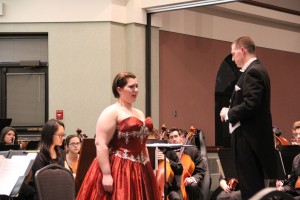
Photo Editor
On Tuesday, April 2, the OWU Chamber Orchestra performed six pieces, including an original by senior Justin Giarrusso, and one with vocal accompaniment by soprano junior Samantha Rammaha, conducted by professor Michael J. Malone.
Giarrusso composed his own piece called “Divertissement Concertante,” which was a work that captured dance aspects such as music used for ballet and featured soloists.
Giarrusso said he was asked to write a piece for the orchestra as part of the “Senior Orchestral Composition” pattern that began last year.
“(Malone) had requested I write something that would feature some of our strong and under-represented players, particularly the concertmaster (first chair, first violinist), principal cello, flute, clarinets, and harp,” he said.
Giarrusso drew inspiration from other composers to create the divertissement, which is often an “inserted segment of ballet.”
“I was thinking a lot about Vivaldi’s concerti while I was writing, especially with the idea of the returning material (ritornello) separated by contrasting sections,” he said.
Giarrusso said he had been working on the piece since November.
“It took all semester worth of rehearsing with the orchestra to prepare for the concert,” he said.
Rammaha sang alongside the orchestra in “Ah! Spietato!” a piece from the 1715 Italian opera “Amadigi di Guala” (“Amadis of Gaul” in English) by Handel.
Rammaha performed as Melissa, a sorceress in a plot of “visions and anguish of the true lovers,” according to the New Grove Dictionary of Opera’s description of the work.
Rammaha said she researched the song and lyrics and translated them from Italian to English before starting to learn the music, as she does with other pieces she performs.
“Understanding the plot of the opera was very important and helped me understand the character I was portraying and interpret the piece better,” she said.
“I also listened to and watched different performances and stagings of this aria so that I could get an idea of how people tended to interpret it.”
She said it takes about five to eight weeks to learn the song and be performance-ready.
“It only takes a week or so to learn notes and rhythms, but assimilating the translation and characterization and memorizing the piece takes the majority of the time,” she said. “It took about another four rehearsals with the orchestra to get the piece to gel with that many musicians.”
Sophomore Connor Stout played the bass for all six pieces, and said it took all semester to learn them.
His favorite was the Haydn’s “Symphony No. 104 in D Major.”
“It was incredibly involved, musically speaking, for its entire length,” he said. “Each movement was had its own infectious tune and it really kept me intrigued.”
Stout also performed in Rammaha’s and Giarrusso’s pieces as a part of the orchestra.
“(Rammaha’s) piece was interesting because the whole orchestra had to monitor their dynamics to match the vocal soloist, as opposed to Justin’s piece that was purely orchestral,” he said. 
“Justin’s piece was in a particularly difficult time signature, so that was the main challenge in that piece.”
Rammaha said her vocal training allowed her to sing this type of aria with ease compared to others.
“If you are learning to sing correctly and use your voice as organically and naturally as possible it should not be vocally strenuous,” she said. “You should not feel like it hurts. It takes years to learn this, and I am still learning.”
Stout, Giarrusso and Rammaha all said they plan on pursuing careers in music, whether in graduate school or beyond.
Stout performed in the Chamber Orchestra for the first time this year, but said he enjoyed it and plans on continuing for the next two years.
“I plan on going to graduate school to get a degree either in vocal performance or songwriting, too,” he said.
Composer Giarrusso said he will be pursuing a master’s degree in music composition next fall.
“I hope to eventually become a composition professor,” he said.
Rammaha said she isn’t planning on participating again, but enjoyed this “rare” experience.
“I think it went very well,” she said.
“I was very pleased with the performance and very grateful for the opportunity.”
Community Market campaign builds
By Cecilia Smith
Transcript Correspondent
The Delaware Community Market will be on the ballot for next year’s off-campus food point program.
Junior Alex D’Amore-Braver, a House of Thought resident, has been campaigning to get the Community Market on the off-campus food point list as his house project for this semester.
The Community Market, located on East William Street, sells local food and gives some proceeds to charities.
D’Amore-Braver has been tabling in the Hamilton-Williams Campus Center to raise awareness for his goal.
“It’s just been strategizing and laying down the groundwork,” he said. “My goal is to make sure the Community Market makes it out of the nomination stage and actually on the food-point program.”
According to D’Amore-Braver, the Wesleyan Council on Student Affairs (WCSA) recently voted to put the market on the ballot for next year. He said the project came from his interest in food issues.
“I’ve read that people are getting away from the source of their food,” he said. “…I would like it in general if people were eating more fresh food and supporting the local economy.”
Because the Community Market is about a mile from the school, D’Amore-Braver said part of his project will include arranging transportation to and from the market, which he hopes will increase patronage from the community. He said he thinks many potential patrons “are the people who aren’t aware of it and who haven’t been there.”
Freshman Mili Green said she didn’t know about the Community Market, but said she would vote to add it to the off-campus program.
“There are times when you need a real meal, you know?” she said. “It would be nice to make it on my own without spending real money.”
D’Amore-Braver said voting for the program will take place in the middle of April.
Gitter predicts Ohio as new destination for Mexican migrants
By Rachel Vinciguerra
Transcript Correspondent
Economics Professor Robert Gitter told students Thursday that one of 20 workers in America can say they were born in Mexico.
Gitter spoke about Mexican migration to central Ohio as part of the Norman J. Gharrity Lecture Series, put on last Thursday at noon by the Department of Economics.
The series is in honor of Gharrity, a retired economics professor who taught at OWU from 1962 to 2005. According to the pamphlet distributed at the lecture, Gharrity had a particular interest in deepening understandings of relations between nations and especially differences of how economies function.
Junior Andrew Paik, student chair of the economics department, said it is part of his job to find speakers for the Norman Gharrity Lecture series.
“It’s designed to promote learning outside of the classroom environment and provide interesting lectures about economics and management for our students,” he said.
He said Gitter selected the topic of his lecture, titled La Travesia A Delaware Y Columbus: A Look at Mexican Migration to Central Ohio.
Gitter said Gharrity was invited to attend on Thursday, and he wished he could have been there.
“I have learned a lot through him,” Gitter said.
Gitter said he wanted to approach the topic of Mexican migration to Ohio from four perspectives: as an economist, as a historian, in relation to public policy and through the lens of current issues and concerns.
From a historical perspective, Gitter said the quotas established for immigration to the United States between 1890-1920 were set based on statistics from 1830-1890.
“I think it’s interesting how laws are passed and what ends up happening can be quite different,” he said.
By the 1940s, the Bracero program had been implemented to bring Mexican workers into the United States for periods of 6 months during World War II, Gitter said. During that time, the U.S. government deported Mexicans through the Immigration and Naturalization Service (INS) and the Department of Labor was stamping their papers and sending them back because there was a need for a workers.
“Then in 1965, LBJ (Lyndon B. Johnson) signed the Immigration and Nationality Act,” Gitter said. “And that’s still a law today.”
The Immigration and Nationality Act abolished the established quotas and dramatically increased the number of people who were allowed into the country.
Gitter said the single most important factor for an immigrant to gain entry to the country today is family reunification. These people will also migrate to places where the cost of living is lower and where their friends, family and townspeople have settled.
“Mexican migrants, then, tend to be more concentrated,” he said.
Gitter said places like California and Texas were the main destination states for Mexican immigrants until the 1990s; but since 2000, that is changing. Today states like North Carolina and Ohio are also major destinations.
“It’s not that they go right from Mexico to Ohio,” he said. “The story is usually, ‘I left Mexico, went to California and wound up in Ohio.’”
He said there are three main concentrations of Mexican migrants in Columbus today: on Broad Street, near the airport and on Morse Road.
Paik said Gitter’s reinforcement of how close to home these issues are struck a chord with him.
“Latin American migration has continued to become a more and more important issue for Americans, not just in California and Texas, but all over the country,” he said. “With immigration reform on the table and the evidence of increasing migration to Ohio…I found the lecture very relevant.”
Gitter said he predicts Mexican migration to the United States will slow as education and political systems improve across Mexico. He also said Mexican migration in the United States will continue to flow to central Ohio.
The lecture ended with a brief set of photographs showing the Latin American presence in central Ohio.
From the Jalisco Market, the Mexican grocery store in Delaware, to pictures of taco trucks in Columbus, Gitter said Mexican populations around Columbus have increased in the last ten years, some with an entrepreneurial bend.
“And the food in the taco trucks is a lot better than Dan’s Deli,” he said.
Junior Rachel Tallmadge said she attended the lecture as a student of economics who was interested in what Gitter had to say.
“I thought the lecture was really insightful and well done,” she said. “I took away from it how difficult and dangerous the labor is that is typically available to Mexican immigrants in the United States.”
Junior Katie Buckingham also attended the lecture because she said she wanted to learn more about Mexican migration.
“I’ve heard him speak on this topic before,” she said. “I thought it was really interesting and well-balanced. I’ll definitely be more aware of the makeup of my surroundings now.”
Paik said the turnout was better than they had expected and even better than the turnout in previous years according to senior Alyssa Ferrando, the outgoing chair.
“I account that to the topic of the lecture since we’ve been using the same type of advertising methods for the last few years,” he said.
Paik said economics department secretary Lisa Garvin should be credited with the success of the lecture, along with other board members
“She was extremely helpful in planning and organizing the event,” he said.
Paik said the event was a success and that he found himself comparing Gitter’s lecture to similar experiences of his friends at OWU.
“One of my acquaintances, who happens to be Guatemalan and also undocumented, lived in one of the areas Gitter described and experienced a very similar form of migration that Gitter described,” he said. “I think this lecture helpful students to understand the experiences of these immigrants.”
